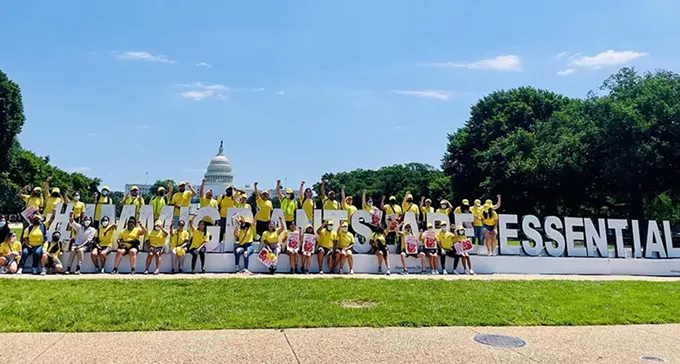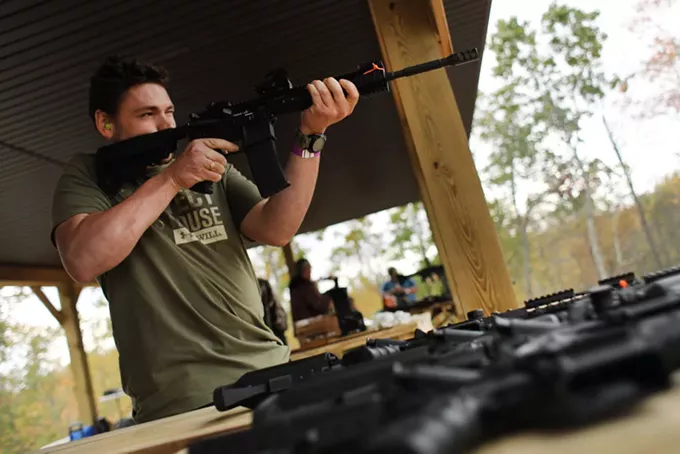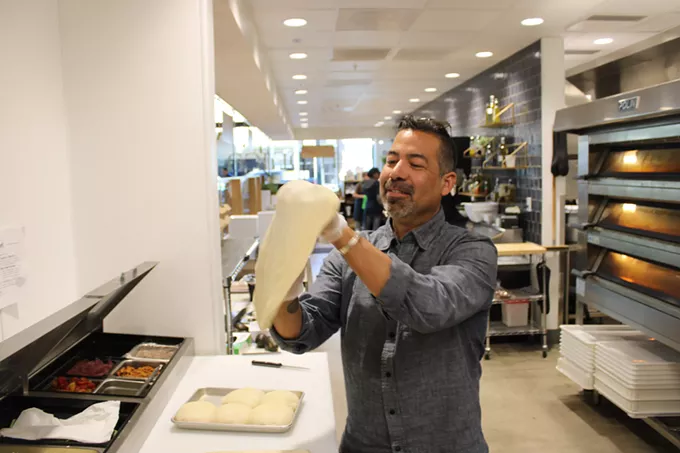Monday, June 20, 2022

High school students in Arizona will soon have to learn how communism and totalitarianism conflict with the American “principles of freedom and democracy” before they can graduate.
House Bill 2008, signed into law Friday by Gov. Doug Ducey, directs the State Board of Education to update its high school social studies academic standards to include a “comparative discussion of political ideologies, such as communism and totalitarianism, that conflict with the principals of freedom and democracy that are essential to the founding principles of the United States of America.”
The bill’s sponsor, Prescott Valley Republican Rep. Quang Nguyen, fled communist Vietnam as a child and cited his upbringing in the country as a major factor in pushing the change to high school curriculum.
“Having grown up in Vietnam and survived three communist invasions, I have a deep love and appreciation for the United States and its freedoms, which are guaranteed to all,” Nguyen said in a press release on the bill’s signing. “This civics standards update will help ensure that our students are taught the brutal facts of oppressive communist systems and how they are fundamentally antithetical to America’s founding principles.”
The bill is similar to a bill passed in Florida last year that was among a litany of other bills in the Sunshine State targeting socialism, communism and civic literacy. Nguyen pushed similar legislation last year, but it failed to win enough support to become law.
The new requirements won’t affect students right away: The standards will have to first be developed by the State Board of Education, which will give parents and the public the opportunity to weigh in.
When the House first took up the bill in February, Nguyen said he had spoken with the State Board of Education about how the standards could be implemented, though he admitted he had not looked at what the current social studies standards currently are.
The bill also creates an oral history library to be used for civic education called “portraits in patriotism” that would be “based on first-person accounts of victims of other nations’ governing philosophies who can compare those philosophies with those of the United States.”

WASHINGTON – It wasn’t a great job – dishwasher – but Mario Montoya was happy because it was his first job and because he needed money for the prom.
But Montoya was happy for another reason, too: The undocumented Mesa resident was only able to work because he was one of the first beneficiaries of the Deferred Action for Childhood Arrivals program when it took effect 10 years ago.
“My life would have been completely different if DACA never came to life,” said Montoya, now 24 and a college graduate. “I don’t know if I would’ve gone to college, or finished it, or thought about it. I wouldn’t be able to work to provide for myself.
“Not sure what my mental state would be as well, to constantly deal with the thought of being deported at any second,” he said this month.
DACA, which protects undocumented immigrants who were brought to the U.S. as children, was enacted on June 15, 2012, by President Barack Obama. In the decade since, the policy has protected as many as 800,000 migrants, including more than 23,000 currently in Arizona.
Critics attacked it as executive overreach and said it would just encourage further migration. But the policy has survived years of legal and political efforts to undo it – as well as the COVID-19 pandemic that made renewals a challenge for recipients.
DACA was initially enacted as a stopgap measure to protect immigrants while Congress worked on comprehensive immigration reform. But Congress never agreed on such legislation, and advocates say it’s time to make the temporary policy a permanent law.
“A permanent solution is due, way overdue now,” said Maria Jesus Cervantes, vice president of public relations for Chicanos Por La Causa. She said that with “the DACA anniversary, there’s a national renewed opportunity to get these issues back in every media outlet, and meeting rooms and board rooms for discussion.”
That’s easier said than done. Congress has tried since 2001 to pass various versions of the Dream Act, which would extend many of the provisions of DACA and sometimes more, like a path to citizenship, which DACA does not allow.
The latest version is the American Dream and Promise Act of 2021, which passed the House with every Democrat and nine Republicans in support in March 2021. That bill has since stalled in the Senate.
In the meantime, immigrants like Montoya look to DACA for protection.
Since 2012, U.S. Citizenship and Immigrations Services has approved 835,097 initial applications for DACA protection, Some experts say the actual number of DACA recipients is probably lower, because the USCIS number includes double-counting of those who let their status lapse before reapplying.
“You can’t compare numbers in full,” said Michelle Mittelstadt, of the Migration Policy Institute. “If you had DACA in 2012, then for two years you did not renew your DACA status, but then popped in 2016, USCIS would count it as the initial applicant.”
As of December, the latest month for which numbers are available, there were an estimated 611,470 DACA recipients in the U.S., with 23,090 of them in Arizona.
Mittelstadt said there are other reasons the numbers may have gone down, such as a DACA holder marrying a U.S. citizen during that time and getting a green card. “About 76,000 DACA recipients at some point during the process were able to get green cards and would no longer need it,” she said.
Another challenge has been COVID-19, which led to a backlog in processing DACA applications and mailing out the cards recipients use to prove they are covered.
“It was definitely a struggle for a lot of people, because they weren’t renewing them as fast because of COVID,” said Michael Browder, a DACA coordinator for the Arizona Dream Act Coalition. “They didn’t have enough staff working on them so they were backed up for like two years.”
Renewals are important – DACA coverage only lasts for two years at a time – and expensive.
When Montoya first applied, the fee was $465. His latest renewal cost $495.
In addition to coming up with the fee, recipients have to remember to apply before their current coverage expires. For those who work and are dependent on DACA, it’s important to stay on top of it, Browder said.
“A lot of jobs will let you stay if you show you’ve applied for your renewal, but a lot of them don’t. They want the actual physical DACA card,” he said.
Montoya has been lucky enough to have the money for renewals and organized enough to keep on top of it. But he said he is frustrated for those who are currently forced to wait, after a federal judge in Texas ordered USCIS to stop processing new applications.
For critics of DACA like Ira Mehlman, the judge made the right call.
Mehlman, spokesperson for the Federation for American Immigration Reform, said that just because a person was brought here without choice by their family, it does not mean that person should be rewarded.
“You can’t condone it, you can’t reward it,” he said of illegal immigration. Mehlman agrees that most DACA recipients are good, decent people but that “doesn’t protect you from the compliance of the law.”
“Every person, every parent understands that their actions are going to have consequences on their children, and when they violate laws it is inevitably going to harm the interests of those children,” he said.
Montoya does not understand that reasoning.
“It doesn’t make sense to push people that want to be part of the community and want to help our economy, pay their taxes and take them away from the only place you know,” he said. “It’s inhumane.”
Montoya, who graduated this spring from Arizona State University with a degree in interdisciplinary studies with concentrations in business and political economy, says that DACA and the work authorization it brought has opened so many doors.
He recalls getting his first DACA card in the mail, months after applying, and the feeling of getting his first job.
“I remember taking a dishwasher position at a buffet, and it was a lot of dishes, and I would be coming home just drained in dishwater,” said Montoya about that first job and the certainty of a regular paycheck.
DACA applicants have to have been brought here as children, remained here continuously, have a clean criminal record, and have to be in school or have graduated. In exchange, they get documentation that lets them work, get a driver’s license and – most importantly – the comfort of knowing they do not have to live in fear of being deported to a country most don’t even remember.
Montoya acknowledges that DACA was supposed to be temporary, but realizes 10 years later that something needs to change.
“There needs to be a permanent solution for DACA recipients, this country is lacking a comprehensive immigration reform,” he said.
Montoya said DACA has brought other changes. He grew up in a “don’t ask, don’t tell” era, when people did not reveal their immigration status, but people are more open with their status today.
“It’s a wonderful shift that people are more brave and open about it,” Montoya said.
And DACA has opened doors that helped him reach his goals, something he wishes for others.
“The opportunity itself can change your whole life,” he said.
For more stories from Cronkite News, visit cronkitenews.azpbs.org.
NEW YORK – Tony Valdovinos is sitting outside New World Stages, a performing arts complex in Manhattan where his life story has been taking center stage in the musical “¡Americano!” for weeks now.
The former Arizona resident is talking about the need to continue the Deferred Action for Childhood Arrivals program – what he calls a “saving grace” in his life – and the role his story plays in that fight. And he’s talking about meeting Barack Obama. Again.
Obama visited the show recently, 13 years after Valdovinos and other immigration activists asked the then-president for help. He said Obama told them to organize, organize, organize.
“To be sitting (there) a foot away from him having a dialogue, a discussion and sharing that story and telling him we did just that,” Valdovinos said of his “incredible” reunion with Obama.
Obama had come to the show to mark the 10-year anniversary this week of DACA, a program that plays as much of a role in “¡Americano!” as Valdovino’s story.
That story has taken Valdovinos, who turns 32 on Sunday, from a Camelback High School senior whose dreams of being a Marine were dashed when he learned he was undocumented, to an immigration activist whose life story is being told in an off-Broadway musical.
“It’s an important year for Dreamers to tell their stories, in this case, now on a global stage,” said Maria Jesus Cervantes, vice president of public relations for Chicanos por la Causa. It partnered with Phoenix Theatre to bring the musical to the stage in Arizona before taking it to New York this spring.
“To tell Tony’s story and so many like him,” Cervantes said, “that despite the barriers that they have, they are able to continue to serve our country through other avenues until they are able to get temporary relief.”
The story begins at Camelback High School where Valdovinos, spurred by 9/11, had dreams of enlisting in the Marine Corps. As a 17-year-old senior, he went to the Marine Corps recruiting officer at the school, scared, but eager to enlist and realize his dream.
But when the recruiter determined that Valdovinos, who had been born in Mexico, was undocumented, he told him to leave. He said Valdovinos was wasting the recruiters’ time.
Confused, embarrassed and angry, Valdovinos went home, where his mother finally revealed to him that the family was “never part of a legal process to get documented.” Valdovinos has said that his citizenship had never been an issue to that point, since he mostly worked construction jobs with his father.
DACA is aimed at undocumented immigrants who were brought to the U.S. as children – like Valdovino. The renewable program protects them from deportation for two years at a time, while providing them with the documentation to work, get a driver’s license, go to school and more.
After DACA took effect in 2012, it opened the door for Valdovinos to land a job as a community outreach director with the Phoenix City Council. He left that job to become field director on what would become Democrat Ruben Gallego’s run for Congress in 2014.
It was during that campaign, that Valdovinos was interviewed by NPR about his canvassing work in local politics. A producer at Phoenix Theatre was listening, and the theater’s artistic director, Michael Barnard, reached out to pitch a musical based on Valdovinos’ experience.
“¡Americano!,” opened at the Phoenix Theatre in late January 2020. Producers’ goal of taking the show to Broadway were complicated by the pandemic, but it debuted off-Broadway on May 1 at the New World Stages.
The show is not only just about Valdovinos’ life and challenges: It is also a story about Dreamers. That resonates with Sean Ewing, the actor who plays Valdovinos in the musical.
“I think that has always been my passion with this piece, delivering and acknowledging the representation and fighting for what we should be fighting for,” said Ewing.
Ewing, who identifies as Colombian, said the play is important for the Latin community, and for the message it delivers about the thousands of Dreamers “who still dream today about the opportunity to live the American dream.”
“¡Americano!,” which ends its run at New World Stages on Sunday, comes as DACA is turning 10 – an anniversary that sparked Obama’s visit to the theater to meet with Valdovinos and four other DACA recipients – and as advocates are mounting a new push to win immigration reform.
DACA has survived several legal and political challenges over the past decade, but it is far from secure. A federal judge in Texas last year found DACA had been created improperly and ordered the government to stop processing new applications. The Biden administration has challenged that ruling, with arguments set for the appeal in July.
Valdovinos knows there’s more work to be done, noting that he and other advocates have been “organizing for 13 years now and we still haven’t found a solution.” But he plans to continue fighting, using his newfound celebrity to elevate the voices of undocumented immigrants in the U.S.
“So much has gone by, even meeting with Obama, (it) was tough to talk about DACA, to talk about the future and to talk about being hopeful,” Valdovinos said. “I think it was a stark reality of how much more time we have ahead of us.”
– Cronkite News reporter Daisy Gonzalez-Perez contributed to this report.
For more stories from Cronkite News, visit cronkitenews.azpbs.org.
Friday, June 17, 2022
Former Arizona Department of Corrections Officer Juan Carlos Rubio, 26, was sentenced to 30 months in prison and two years of supervised release, according to a U.S. Attorney’s District of Arizona Office press release.
In early 2020, Rubio, a Tucson resident, colluded with smugglers to bring three firearms and 500 AK-type rifle magazines into Mexico from the United States, according to federal prosecutors.
Rubio was charged for lying to a licensed gun dealer that the gun he purchased would be for himself. Instead, he bought the gun for another individual. Rubio also conspired with a third party to obtain another weapon from a licensed dealer. The third party lied to the dealer, saying the weapon was for themself before giving the gun to Rubio.
Rubio had already pleaded guilty to four counts of conspiracy to smuggle goods from the United States, smuggling goods from the United States, false statements in connection with the acquisition of a firearm, and aiding and abetting false statements in connection with the acquisition of a firearm, according to the press release.
The investigation of Rubio's actions was done as part of the Department of Justice’s Project Safe Neighborhoods (PSN) Program. The Department of Justice says this program is evidence-based and is shown to reduce violent crime in local communities.
Thursday, June 16, 2022
Don Guerra, the founder of Barrio Bread, took home the Outstanding Baker Award at the James Beard Awards in Chicago on Monday, June 13.
But Guerra says he doesn’t plan to rest on this particularly noteworthy laurel. Instead, he looks at the award as another ingredient in his recipe for success.
“It feels surreal right now,” Don laughed. “You know, it is definitely a recognition that I am on the right path with my profession. I love baking and I have been in love with it for 30 years.”
The James Beard Awards are considered the “Oscars of Food” and are granted to those who have performed exceptional work in the culinary arts with focus on talent, hospitality, the broader food system and sustainability. Guerra was previously nominated for this national award twice, in 2019 and 2020.
It’s a huge honor for Guerra, who started out baking about 900 loaves of bread a week in 2009 with his Italian Dutch oven in his garage, with his main focus on feeding the community—hence the name “Barrio Bread.”
Today, his mission stays the same: To feed and cultivate the community of Tucson with a hyper-local model.
The Beard Award is just the latest milestone for Guerra, whose work has been celebrated in national publications. The New York Times called him “a leader of the local-grain movement in Tucson” who “challenges others to reimagine craft baking with an eye towards Latino and Indiginous roots.”
Guerra’s Natural Love and Bread uses local grains and an ancient French sourdough technique without sugars or oils.
During the pandemic, Guerra was able to feed his community due to his “grain chain,” a hyper-local model he has used since he started baking bread and ran his own bakeries in his 20s.
Guerra finds all his ingredients within 100 miles from Tucson. He has recruited farmers to plant grain through the U.S. Department of Agriculture grant under the Sustainable Agriculture Research Education (SARE) program, which not only enhances the local economy, but also reduces pollution and shines a light on Tucson’s indigenous lands and history.
Guerra was able to provide large supplies of flour to Tucsonans during the pandemic due to the thousands of pounds from his local farms. He also had instructional videos on his website teaching the community about how to bake Natural Love and Bread.
Outreach education is a priority. He worked as a teacher in the Tucson Unified School District for seven years and has traveled all over the world to share his hyperlocalism model and Natural Love and Bread, including speaking events in Mexico, Taiwan and Poland.
Guerra also paired up with Carlotta Flores, owner of El Charro, and her family to open Barrio Charro, as well as the pantry-styled restaurant that recently opened downtown, The Monica. Guerra and Flores were recently featured on Bravo’s Top Chef for the season 19 finale that was filmed in Tucson.
Moving forward into his next chapter, Guerra plans to continue bringing light to localism in Tucson and serving his neighborhood.
“For me, it has really been about my community, feeding my community,” he said. “Teaching and learning with my community has created this passion. I feel this encouragement from my community to do my best and contribute.”
To hear more about Guerra’s journey as a baker, listen to the Prickly Pair Podcast on Apple Music and Spotify.
WASHINGTON – The Supreme Court on Wednesday dismissed Arizona’s attempt to defend a Trump-era “public charge” that would have made it harder for immigrants to gain permanent residency, after the Biden administration refused to defend the policy.
Wednesday’s decision means that lower court rulings that had blocked the public charge rule will stand, an action that one migration lawyer said closes the door on “a very dark chapter of the weaponization of the public charge rule.”
Adriana Cadena, director of Protecting Immigrant Families Coalition, said Wednesday’s ruling “paves the way for the Biden administration to issue public charge regulations that improve protections for immigrant families.”
“It ensures that eligible immigrant families can continue to get the care and help every family needs,” she said in an email.
But Arizona Attorney General Mark Brnovich, who led the fight by 14 states to defend the rule after it was dropped by the Biden administration, said in a prepared statement that despite the ruling, the “coalition of states will evaluate how best to continue this important fight.”
“Allowing the Biden administration to recklessly abandon the defense of such rules will further the devastating consequences of this border crisis – now and for many years to come,” said Brnovich spokesperson Brittni Thomason in a statement.
The rule, which has been on the books for more than 100 years, allows the government to deny admission or permanent residency to immigrants who cannot prove that they will not rely on public assistance or are not “likely at any time to become a public charge.”
The Trump administration in 2019 interpreted the rules more broadly and expanded the programs and benefits that can be considered a “public charge” when determining immigration status.
That rule was immediately challenged by governments and advocates across the country, who went to court seeking – successfully in most cases – to block the law that they said would deny basic necessities to their residents. The Trump administration fought back.
But shortly after taking office in 2021, the Biden administration said it would no longer enforce the harsher interpretation of the public charge rule that it said “was not consistent with our nation’s values.” It also stopped defending the rule in courts, then pointed to a U.S. District Court ruling from Illinois that vacated the regulation and said U.S. Citizenship and Immigration and Citizenship Services would no longer be able to enforce it.
That prompted Brnovich and attorneys general from other conservative states to file a motion seeking to take the place of the federal government and defend the rule in the 9th U.S. Circuit Court of Appeals. The circuit court refused, sparking the appeal to the Supreme Court.
The states argued in February that the federal government violated the Administrative Procedure Act by dropping the rule without first giving notice and holding public hearings on the issue.
But the Supreme Court did not rule on that argument, instead dismissing the case Wednesday as having been “improvidently granted” – essentially that it made a mistake agreeing to hear the case in the first place.
In a concurring opinion, Chief Justice John Roberts said the court was right to dismiss the case, which he called a “mare’s nest” of issues that could make it difficult for the court to decide if the Biden administration violated the process for dropping the rule. But he said it is still an issue that need to be looked at by the court.
Roberts said a new administration is entitled to decide what policies to defend, but that the Biden administration “took a further step” that let it “circumvent the usual and important requirement” of giving notice under the APA.
“As part of this tactic … the government successfully opposed efforts by other interested parties … to intervene in order to carry on the defense of the Rule, including possibly before this court,” he said in the concurrence that was joined by Justices Clarence Thomas, Samuel Alito and Neil Gorsuch. The dismissal “should not be taken as reflective of a view on any of the foregoing issue” or any current or future litigation, he wrote.
Brnovich had said that “commonsense immigration policy requires noncitizens to be responsible, self-sufficient, and contributing members of society in order to obtain green cards,” arguing before the Supreme Court in February that this country is the “land of the free and of industrious immigrants, but it is not a welfare state.”
He has said that implementing the Trump-era rule would save states over $1 billion in direct payments for programs such as food stamps, Medicaid and Temporary Assistance to Needy Families.
Advocates say those programs are there for a reason.
“These programs are designed to serve children of low-income households,” said Jose Patiño, vice president of education at Aliento. “For me, anything that we create programs to support children, I would normally support.”
Patiño said some immigrant families stopped applying for benefits, even during the pandemic, because “they feared that that would be considered within the public charge rule” and that it would affect consideration of their immigration status.
“Because of misinformation a lot of folks still have not fully come back in terms of applying for the programs and benefits that they were entitled to,” he said.
The Biden administration proposed a new public charge rule in February that it said will not penalize individuals for “choosing to access the health benefits and the other supplemental government services available to them.”
The proposed rule would drop the Supplemental Nutrition Assistance Program, the Children’s Health Insurance Program, housing and transportation benefits, and pandemic assistance from those programs that would affect a public charge determination.
For more stories from Cronkite News, visit cronkitenews.azpbs.org.
WASHINGTON — Parents of children under 5 are one step closer to vaccinating their young kids against COVID-19 after the U.S. Food and Drug Administration’s outside vaccine panel recommended emergency use authorizations of two COVID-19 vaccines Wednesday.
The 21-person Vaccines and Related Biological Products Advisory Committee voted unanimously to recommend the FDA approve emergency use authorizations for a three-dose Pfizer vaccine and a two-dose Moderna vaccine.
If the FDA does issue its authorization later this week and the Centers for Disease Control and Prevention recommends use, shots will likely begin next week.
Dr. Peter Marks, director of the FDA office responsible for assuring the safety and effectiveness of vaccines, began the day-long meeting Wednesday citing the high number of children hospitalized during the omicron wave this winter, as well as the 442 kids younger than 4 who have died since the start of the pandemic
“We are dealing with an issue where I think we have to be careful that we don’t become numb to the number of pediatric deaths because of the overwhelming number of older deaths here. Every life is important,” Marks said. “Each child that’s lost essentially fractures a family.”
Vaccines for illnesses like the flu, Marks said, are something parents have accepted in the past to try to prevent their children from dying.
“Here we have a different pathogen, but one that has created a lot of havoc just the same,” Marks continued.
Two shots for Moderna
The Moderna vaccine, about a quarter of the dose of the adult vaccine, would be administered in two shots, with the second given a month after the first.
Side effects for children between 6 months through 36 months of age include fever, irritability, crying, sleepiness and loss of appetite. Study participants between the ages of 37 months and 5 experienced fever, headache, fatigue, muscle aches, joint stiffness, nausea/vomiting and chills.
Four children between 16 and 19 months experienced febrile seizures following the vaccine, with two of those happening within 10 days, one 21 days later and one 66 days after vaccination. Three of the seizures were deemed not related to the vaccine by investigators.
Three shots for Pfizer
The Pfizer vaccine dose is about one-tenth the adult vaccine. The second dose is given three weeks after the first, with the third dose coming at least two months later.
Side effects for Pfizer for children between 2 and 5 years old included fever, fatigue, headache, chills, vomiting, diarrhea, muscle pain and joint pain. Children between six months and 2 years experienced fever, decreased appetite, drowsiness and irritability.
Study participants had some redness, tenderness and swelling at the injection site for both vaccines.
Moderna filed for emergency use authorization for its two-dose vaccine for children between six months old and 6 years old on April 28.
The company said in a statement the vaccine was 51% effective for kids between 6 months and 2 years old and 37% effective for children between 2 and 6.
Pfizer announced its request for an EUA for a three-dose COVID-19 vaccine on May 23, saying in a statement that the specialty vaccine was 80.3% effective in children 6 months to 5 years.
That number, however, is based on just 10 symptomatic COVID-19 cases and the FDA advisory panel members expressed concern Wednesday that might not be the level of protection when the Pfizer vaccine is given to a much larger number of children.
“We have to be aware of the fact that we care tremendously at FDA about the safety and effectiveness of these vaccines, and we will continue to monitor these vaccines as they are deployed,” Marks said.
Any evidence of additional side effects from the two COVID-19 vaccines for young kids would be quickly released, Marks noted.
Shots by next week?
White House COVID-19 Response Coordinator Ashish Jha said earlier this month that the federal government would begin shipping doses of the vaccine formulated for young kids as soon as the FDA authorized one, or both, of the vaccines.
While doses cannot be administered until after the CDC recommends emergency use, Jha said, he expected shots could begin next week.
“We have asked states to distribute the initial tranche of doses to their highest priority sites, including those serving the highest-risk children and hardest-to-reach areas,” Jha said at the time. “We’ve also asked them to prioritize sites that can handle large volumes, such as children’s hospitals.”
While Jha said, it would take “some time to ramp up the program and for vaccinations to be more widely available,” he also said “that within weeks every parent who wants their child to get vaccinated will be able to get an appointment.”
The federal government has enough funding to distribute free vaccines for kids under 5 despite the Biden administration issuing dire warnings about the fate of testing, treatment and vaccines amid a funding stalemate with Congress.
It’s not clear, however, how many parents will get their young children vaccinated with either the Pfizer or Moderna vaccine.
Thirty percent of kids in the 5 to 11 age group that became eligible for COVID-19 vaccines in October were fully vaccinated as of June 1, according to the CDC.
Those numbers have increased steadily during the last six months, rising from 3.8% in the beginning of December to 23% in early February to 28% on April 1.
The number of fully vaccinated children between 12 and 17 is nearly double, with about 60% of those eligible being fully vaccinated.
A Kaiser Family Foundation poll conducted in April showed that about 18% of parents plan to get their children under 5 vaccinated right away while 38% of parents said they would wait and see.
Another 11% said they would only get their young children vaccinated if it was required and 27% said they definitely wouldn’t get them vaccinated.
Availability of information about the newly authorized COVID-19 vaccine for young kids is one of the main factors behind parents’ hesitance, with 56% saying they don’t have enough information about the vaccine’s safety and effectiveness, according to the poll.
Jha said during a separate press conference this month that the Biden administration doesn’t have any “internal targets” of how many young children should be vaccinated after a week or a month or three months.
“A reminder that these things take time, that vaccine confidence builds over time,” he said. “It builds with trusted voices, physicians, faith leaders, others helping people get vaccinated. This is not a one-and-done, this is not an automatic.”
Wednesday, June 15, 2022

WASHINGTON — U.S. Senate Minority Leader Mitch McConnell on Tuesday said he is comfortable with the bipartisan deal Senate Democrats and Republicans struck on gun control legislation, signaling that he will join in passing a bill when it comes to a vote.
“For myself, I’m comfortable with the framework,” the Kentucky Republican said during a press conference. “And if the legislation ends up reflecting what the framework indicates, I’ll be supportive.”
The push for gun legislation follows the second-deadliest school shooting in a decade, in which 19 children and two teachers were murdered in Uvalde, Texas on May 24. It followed another mass shooting in Buffalo, New York, on May 14, where a white supremacist targeted a Black neighborhood and killed 10 Black people at a grocery store.
A bipartisan group of 20 senators — including 10 Republicans, the number needed to advance a bill past a filibuster — announced a framework early Sunday and are quickly moving to draft the bill’s specific wording, or text.
The lead Democrat on the framework, Sen. Chris Murphy of Connecticut, said a component of the bill would be an expansion of mental health, with somewhere in the billions for funding. But he did not give more details on how much money will be provided for those services.
“Given the opportunity to spend billions of dollars fixing our mental health system, we would be foolish not to take up that opportunity,” he told reporters Tuesday. “We certainly haven’t announced any numbers — we’re still working on that.”
Senate Majority Leader Chuck Schumer, a New York Democrat, said on the Senate floor that once there is legislative text for the bill, he will quickly call a vote, aiming for passage before the July 4 recess.
“The bipartisan framework is far from perfect, but if passed it will unquestionably save lives and would be the most significant action on guns that the Senate has taken in nearly three decades,” he said.
“This is the best chance we’ve had in years to finally tell the American people that, yes, after the horrifying tragedies of Uvalde and Buffalo, this time, this time will be different.”
The framework would provide funding to states to establish red flag laws, which allow the courts or law enforcement to temporarily remove a firearm from an individual who is distressed and poses a harm to either themselves or someone else.
It would also close the “boyfriend” gun purchase loophole by requiring convicted domestic violence abusers and those subject to domestic violence restraining orders be included in background checks, including “those who have or have had a continuing relationship of a romantic or intimate nature.”
It would also allocate funding for school resources such as mental health and violence prevention programs and require gun buyers under 21 to undergo a background check that includes a review of juvenile and mental health records.
Access to juvenile records
Sen. Roy Blunt, a Missouri Republican who is part of the bipartisan coalition, said that an important component of the bill is having access to juvenile records if someone under 21 wants to purchase an assault weapon.
Democrats tried to raise the age of purchasing an assault weapon, the type of firearm used in most mass shootings, from 18 to 21, but the provision was stripped out during negotiations. The legal age to buy a handgun is 21.
“The person in Uvalde, who on his 18th birthday underwent a background check to buy a gun, and since you have no earlier records from 18 available, it’s like that person was born that day,” Blunt said at a press conference.
Blunt said the group is hoping to have the bill text written by the end of this week or next.
House package
The Democratic-controlled House passed its own gun control package last week, but it has little chance of being brought to the Senate floor for a vote.
That collection of earlier bills raises the age of purchasing semiautomatic rifles from 18 to 21, creates new requirements for storing guns in a home with children, prevents gun trafficking, requires all firearms to be traceable and closes the loophole on bump stocks, devices that increase the rate of fire of semiautomatic weapons, among other things.
The White House and Democratic leaders signaled their support for the Senate framework on Monday, and all pushed for more to be done.
The last time Congress passed major gun control legislation was in 1994, when former President Bill Clinton signed into law a ban on assault rifles, but it was temporary and ended in 2004.
The Senate Democrats and one independent in the bipartisan group along with Murphy are Kyrsten Sinema of Arizona, Richard Blumenthal of Connecticut, Cory Booker of New Jersey, Chris Coons of Delaware, Martin Heinrich of New Mexico, Mark Kelly of Arizona, Angus King of Maine, Joe Manchin of West Virginia and Debbie Stabenow of Michigan.
The 10 Senate Republicans in the bipartisan group, including Blunt, are John Cornyn of Texas, Thom Tillis of North Carolina, Richard Burr of North Carolina, Bill Cassidy of Louisiana, Susan Collins of Maine, Lindsey Graham of South Carolina, Rob Portman of Ohio, Mitt Romney of Utah and Pat Toomey of Pennsylvania.
Gun rights groups
The National Rifle Association issued a statement following the announcement of the bipartisan agreement saying that the organization would not comment on the framework.
“We will make our position known when the full text of the bill is available for review,” NRA wrote in a statement. “The NRA will continue to oppose any effort to insert gun control policies, initiatives that override constitutional due process protections and efforts to deprive law-abiding citizens of their fundamental right to protect themselves and their loved ones into this or any other legislation.”
But another large gun rights group, the Gun Owners of America, has already come out opposing the framework and is pressuring senators to oppose the deal.
“There is absolutely NO compromise acceptable to (Gun Owners of America),” the organization wrote in a statement. “These are our rights, and we shouldn’t surrender an inch of them to anyone.”
Arizona State Senate Republican leaders announced Tuesday that they want to make it illegal for anyone under 18 to attend drag shows in Arizona, though the actual details of what will be proposed are a “work in progress,” the measure’s likely sponsor said.
“In a civil society, you don’t bring your children up like that,” said Sen. Vince Leach, a Republican from Saddlebrooke.
Leach said he has been mulling legislation barring children and teenagers from drag shows since last year, when he learned of a University of Arizona drag show for children. Then in March, Tucson Magnet High School held a drag show for students. But each time, other legislative concerns prevented action, he said.
The final straw, Leach said, was seeing an Indigenous drag show at the Heard Museum in Phoenix earlier this month.
He said images of drag shows circulating online have shown performers with their “crotch wide open” in front of young children.
Exactly what form the proposed ban will take remains to be seen, as Leach acknowledged that he hasn’t begun drafting the legislation yet. He said his desire is to implement a statewide ban, but conceded that doing so would run up against “free-market concerns,” so it might only be limited to public institutions, like schools.
The effort would capitalize on a growing movement that has been spurred on by a group of self-described “Christian fascists” and broadcast right-wing media outlets.
And the proposed Arizona ban comes on the heels of an event in Dallas this month that was overtaken by far-right extremists associated with the America First and groyper movement who identified themselves as “Christian fascists.”
The group was protesting at a family-friendly drag queen brunch and was led by white nationalist John Doyle, who at one point encouraged the local police to enter the establishment and “put bullets in all their heads.”
Multiple right-wing media outlets claimed that the event was “grooming” children in a scheme similar to conspiracy theories such as the ones that circulated with QAnon and “pizzagate,” which both center on global networks of pedophiles and child traffickers.
Within days, a Texas GOP lawmaker had issued a press release announcing that he would introduce legislation to ban drag performances in the presence of minors. Later that evening, a Florida Republican legislator said he would introduce a measure to terminate the parental rights of any parent who allows their children to attend a drag show.
Leach didn’t cite the Dallas event in an interview with the Arizona Mirror, but he wrote on Twitter that it was “Disgusting!!”
“This is a national trend that we have been seeing pop up very quickly,” Jeanne Woodbury, policy and communications director for Equality Arizona, told the Mirror. Equality Arizona is a non-profit organization that advocates for the LGBTQ+ community in Arizona.
“There is no violence associated with drag,” Woodbury said. “Drag isn’t something that is violent. This is an agenda that is set out to drive gay people and queer people into the margins and prosecute trans people just for living.”
Woodbury said she is concerned about what the future legislation may look like, as the LGBTQ+ community has been the past target of policies that have criminalized their existence, and this new legislation could lead to that again.
In the 1960s, it was illegal for same-sex couples to hold hands, kiss or dance, leading for many in the community to seek refuge in gay bars like the Stonewall Inn in New York City. The Stonewall Inn is most famous for the “Stonewall Uprising,” when police raided the establishment and protests erupted, resulting in a watershed moment for the LGBTQ+ rights movement.
“Pride is a month that we celebrate and commemorate the Stonewall uprising,” Woodbury said, adding that the community and lawmakers need to reflect on that fact. “We need to look at this legislation as something that affects all of us, as something we can push back on collectively about being honest about what it is going to mean.”
Woodbury said she is concerned about the potential breadth of the legislation. If it’s written too broadly, she said, it’s possible that a transgender individual could face criminal charges for simply being in public near a minor.
Leach said he wants to avoid infringing on free speech and parental rights in trying to “protect our children” from being exposed to sexualized content at drag shows.
“Parents know best, but we know that giving marijuana candy to a six-year-old will get you a visit from DCS,” he said, referring to the state’s Department of Child Safety.
At other points, Leach likened banning youth from drag shows to existing laws prohibiting children from entering bars, going to strip clubs and doing heroin. He said the comparisons were fair, though he conceded there’s a “fine line” in making them.
Woodbury hopes that Republican senators she has worked with throughout the session will not support the bill.
“I know that there are Senate Republicans of good will that I have enjoyed working with over the course of this session and I would like to think that they would look at this for what it is and what it would mean that they would not support it,” Woodbury said.
It is unclear what other states Leach is working with or if he is working with any stakeholders to craft the legislation. The Mirror reached out to the Center for Arizona Policy, an anti-LGBTQ+ organization that frequently works with lawmakers in the state on similar legislation, but did not get a response.
Thursday, June 2, 2022
If you like sand, cerveza and Sergio Mendoza, you'll want to be in Rocky Point at the end of September.
Orkesta Mendoza featuring Quetzal Guerrero will join Mariachi Nuevo Azteca, Salvador Duran, Puerto Peñasco band Agua de Coco and DJ Los Esplifs for a concert benefiting CEDO Intercultural, the longtime research lab on the shores of the Gulf of California.
The festival will take place over three nights from Sept. 30 to Oct. 2 at CEDO in Rocky Point, aka Puerto Peñasco. The beachside fishing village and tourist town is a four-hour drive from Tucson and Phoenix.
"I'm honored to be part of this bill along with friends from Tucson," Mendoza said in a Facebook post announcing the show.
CEDO—which stands for Centro Intercultural de Estudios de Desiertos y Océanos, or the Intercultural Center for the Study of Deserts and Oceans—has been in operation for more than 40 years. Legions of researchers, students and visitors have passed past the iconic whale skeleton in front of its location in the dunes of housing development Las Conchas to learn more about the delicate ecosystem where the desert meets the sea.
For more details, visit musicforthesea.mx.









